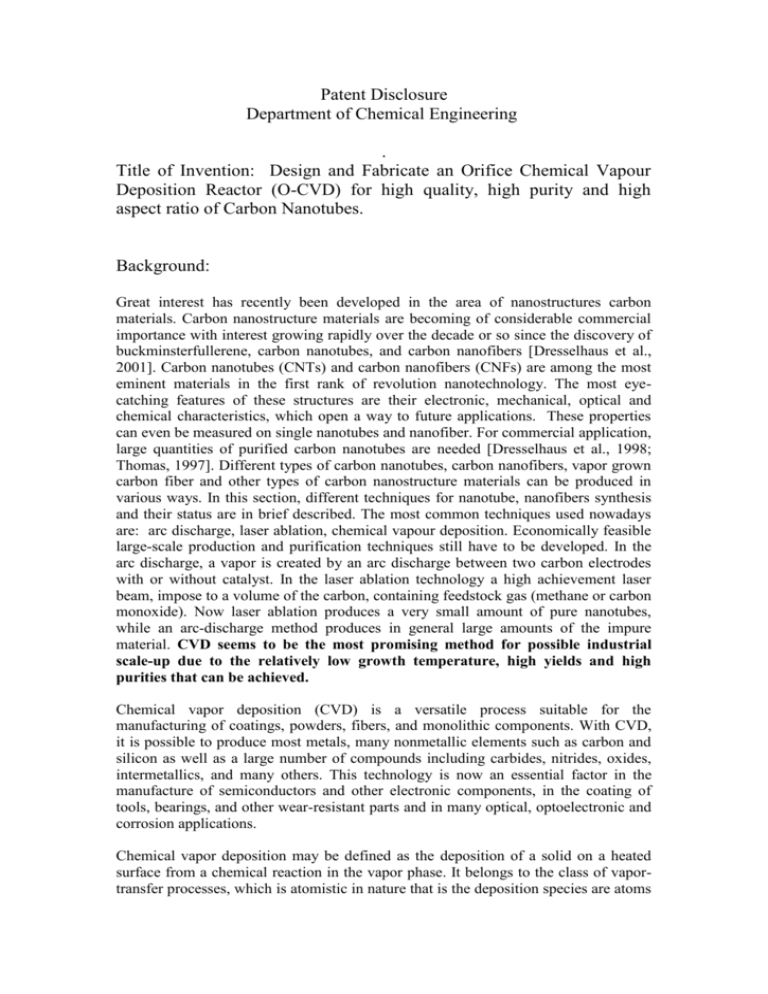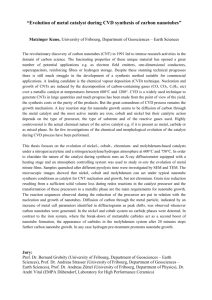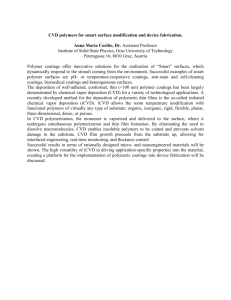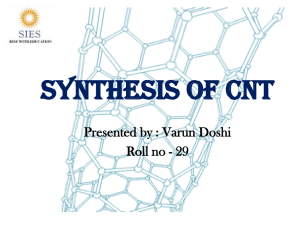Patent Disclosure
advertisement

Patent Disclosure Department of Chemical Engineering . Title of Invention: Design and Fabricate an Orifice Chemical Vapour Deposition Reactor (O-CVD) for high quality, high purity and high aspect ratio of Carbon Nanotubes. Background: Great interest has recently been developed in the area of nanostructures carbon materials. Carbon nanostructure materials are becoming of considerable commercial importance with interest growing rapidly over the decade or so since the discovery of buckminsterfullerene, carbon nanotubes, and carbon nanofibers [Dresselhaus et al., 2001]. Carbon nanotubes (CNTs) and carbon nanofibers (CNFs) are among the most eminent materials in the first rank of revolution nanotechnology. The most eyecatching features of these structures are their electronic, mechanical, optical and chemical characteristics, which open a way to future applications. These properties can even be measured on single nanotubes and nanofiber. For commercial application, large quantities of purified carbon nanotubes are needed [Dresselhaus et al., 1998; Thomas, 1997]. Different types of carbon nanotubes, carbon nanofibers, vapor grown carbon fiber and other types of carbon nanostructure materials can be produced in various ways. In this section, different techniques for nanotube, nanofibers synthesis and their status are in brief described. The most common techniques used nowadays are: arc discharge, laser ablation, chemical vapour deposition. Economically feasible large-scale production and purification techniques still have to be developed. In the arc discharge, a vapor is created by an arc discharge between two carbon electrodes with or without catalyst. In the laser ablation technology a high achievement laser beam, impose to a volume of the carbon, containing feedstock gas (methane or carbon monoxide). Now laser ablation produces a very small amount of pure nanotubes, while an arc-discharge method produces in general large amounts of the impure material. CVD seems to be the most promising method for possible industrial scale-up due to the relatively low growth temperature, high yields and high purities that can be achieved. Chemical vapor deposition (CVD) is a versatile process suitable for the manufacturing of coatings, powders, fibers, and monolithic components. With CVD, it is possible to produce most metals, many nonmetallic elements such as carbon and silicon as well as a large number of compounds including carbides, nitrides, oxides, intermetallics, and many others. This technology is now an essential factor in the manufacture of semiconductors and other electronic components, in the coating of tools, bearings, and other wear-resistant parts and in many optical, optoelectronic and corrosion applications. Chemical vapor deposition may be defined as the deposition of a solid on a heated surface from a chemical reaction in the vapor phase. It belongs to the class of vaportransfer processes, which is atomistic in nature that is the deposition species are atoms or molecules or a combination of these [Hugh, 1999]. CVD has several important advantages, which make it the preferred process in many cases. These can be summarized as follows [Hugh, 1999]: CVD is a relatively simple and flexible technology, which can accommodate many variations. With CVD, it is possible to coat almost any shape of almost any size. Unlike other thin film, techniques such as sputtering CVD can also be used to produce fibers, monoliths, foams and powders. CVD is economically competitive. In the CVD-method different hydrocarbons such as benzene (C6H6), pentane (C5H12), acetylene (C2H2), methane (CH4) and carbon monoxide is decomposed over different metals (Fe, Co, Ni) at temperatures between 500 and 1200°C. This method was used for a long time for the synthesis of carbon fibers [Tomita et al., 1971; Lahaye et al., 1973; Da Silva et al., 1976; Oberun et al., 1976; Baker et al., 1983; George 1984; Takafumi et al., 1992; Munehiro 1992 & 1993; Serp and Madron 1999 and Li et al., 2001] and nanofiber [Hulteen et al., 1997; Lijie et al., 2000 & 2001; Yue-Ying et al., 2000; Cheol et al., 2001; Sun et al., 2001; Yih et al., 2001; Young and Hong 2001; Yue et al., 2001; Charanjeet et al., 2002; Hondaa et al., 2002; Guo-Bin et al., 2004 and Jipeng et al., 2004 ] but there were no indications that it could also be used for the synthesis of carbon nanotubes until Yacamán et al., (1993) reported this method the first time for the production of nanotubes. The CVD method deposits hydrocarbon molecules on top of heated catalyst material. Metal catalysts dissociate the hydrocarbon molecules. Figure 7.5 shows the apparatus of the CVD process. The CVD method produces both single-wall and multi-wall nanotubes. The CVD process uses hydrocarbons as the carbon source. Hydrocarbons flow through the quartz tube where it is heated at a high temperature [Sinnot et al., 1999]. The energy source is used to “crack” the molecule into reactive atomic carbon. Then, the carbon diffuses towards the substrate, which is heated and coated with a catalyst (usually a first row transition metal such as Ni, Fe or Co) where it will bind. Carbon nanotubes will be formed if the proper parameters are maintained. Excellent alignment, as well as positional control on nanometer scale, can be achieved by using CVD. Control over the diameter, as well as the growth rate of the nanotubes can also be maintained [Yudasaka et al., 1995, Xin et al. 2009]. The appropriate metal catalyst can preferentially grow single rather than multi-walled nanotubes. In the last decennia, different techniques for the carbon nanotubes synthesis with CVD have been developed, such as: i) vapor phase growth CVD; ii) substrate catalyst CVD; iii) plasma enhanced CVD; iii) fluidized-bed CVD; these different techniques are explained in more detail in this chapter [Dresselhaus et al., 1998]. Present of the invention: The invention describes the fabrication of the new type of chemical vapour deposition that produce high quality, high purity and high aspect ratio of Carbon Nanotubes. Our aim is to fabricate a very advanced and sophisticated Orifice Chemical Vapor Deposition (VO-CVD) reactor with simple features at a reasonable cost, in order to produce a high purity and quality of CNT. 1. The reactors consist of two tubular furnaces with maximum operating temperature 1200 oC. 2. The reaction chamber is a quartz tube of 50 mm in diameter and 1500 mm in length and heat by silicon carbide heating element. 3. The catalyst was fixed at the first reaction chamber while the second reaction chamber was used for the reaction and growth processes. 4. Three types of gases was used in this system, hydrogen was as a reacting gas and the argon for flashing the air from the system while acetylene gas was used as a source of hydrocarbon, and all of them was controlled by a flow meter. 5. Three stainless steel orifice with different diameter size of the orifice range from Do =3 mm, 6 mm to 12 mm were used and placed at beginning of the reaction zone (second tubular reactor). 6. The orifices are cylindrical shape with length of 5 cm and outer diameter size of 5 cm. 7. The hole of the orifice was drilled at the centre of the stainless steel. 8. The shape of the orifice hole is cylindrical shape. Another way of the fabrication of the O-CVD can be fabricated 9. Vertical Orifice Chemical Vapor Deposition (VO-CVD) reactor with simple features at a reasonable cost, in order to produce a high purity and yield of CNT can be fabricated. 10. The reactors consist of two Vertical tubular furnaces with maximum operating temperature 1200 oC. 11. All types of orifices can be used such as Orifice Plate, Venturi Tube, Flow Nozzles and Variable Area orifice 12. All reactor sizes can be sued starting from small diameter 1'' up large diameter 40 '' 13. All types of gas and liquid hydrocarbon can be used as source of carbon 14. All reactor position such as o degree, 45 degree, 90 degree can be used and effect of gravity can be study. 15. Any type of inert gas such argon, nitrogen and helium can be used along with hydrogen flow rate during the reaction to increase the gas residence time. 16. All type of gas flow (Turbulent, transition and laminar) can be investigate to the study of the gas flow on the production of carbon Nanotubes.




